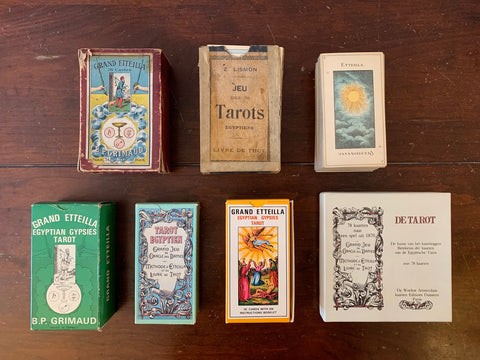Etteilla Tarot Deck
Etteilla, The Wigmaker
Etteilla (1738-1791) born Alliette, was a barber by profession, who changed his name into Etteilla (spelled backwards, after the Hebrew tradition), when he became involved in occult thinking and, according to many, became a full-time fortuneteller.

Being a barber and a skillful wigmaker, he had little further education and not
much experience with the philosophies of the more initiated. Nevertheless, he was gifted with a profound intuition (and a convincing fantasy). Contemporaries like Eliphas Levi, even believed that he came very near unveiling ‘The Real Secrets behind the Tarot’, but Levi also stated that his thoughts, when put into writing, were ‘obscure, wearisome, and in style even barbarous’.
Etteila was probably influenced by Comte Court de Gebelin (1728-1784), who led many occultists of those days to believe in the possible Egyptian roots of the Tarot.
According to Lewis Spence in An Encyclopedia of Occultism (Routledge & Sons, 1920): ‘He [Etteilla] claimed to have revised the Book of Thoth, but in reality, he spoilt it, regarding as blunders certain cards whose meaning he had failed to grasp. It is commonly admitted that he failed in his attempt to elucidate the tarot, and ended by transposing the keys, thus destroying the correspondence between the numbers and the signs. It has also been said of him that he had degraded the science of the Tarot into the cartomancy, or fortune-telling by the cards, of the vulgar...’.
Seligmann, in the Mirror of magic (New York, 1965), quotes:
‘Alliette, the vainglorious hairdresser, decided that the Tarot game should be rectified, and reinstated to its original glory. He changed the sequence of the leaves, discarding some and adding new ones which he declared were the oldest images, lost during the peregrinations of the game from Egypt to Europe – in brief, he confused everything completely.'
Although the afore mentioned claim regarding the Book of Thoth and the then current work Of Comte Court de Gebelin might have led to a deck full of Egyptian symbolism, the ‘Tarot Egyptien (Grand Etteilla)’ does not look as anything particularly Egyptian. Etteilla even added extra attributes like astrology and cabala to the cards.
The cards look different than the ones from contemporary decks of that time, for instance the various Tarot de Marseille decks (TdM). The Grand Etteilla is believed to be one of the
first real ‘Fortune Telling Decks’. That is probably not what he himself had in mind and does not really do justice to the Tarot as a whole. All in all, the images of the cards remain inspiring and offer quite a unique theater of divination as was common in those days.
The deck shown on these pages is from ca. 1890, published by B.P. Grimaud, Paris.
Title: Grand Etteilla, Manière de tirer le Grand Etteilla out tarots égyptiens compose de 78 cartes et de 118 tableaux. No box. Card 62 show the original duty stamp of the French Tax Service.
Scroll all the way down to see a photo showing all Etteilla decks in our collection!





Take a look at all Etteilla decks in our collection:
